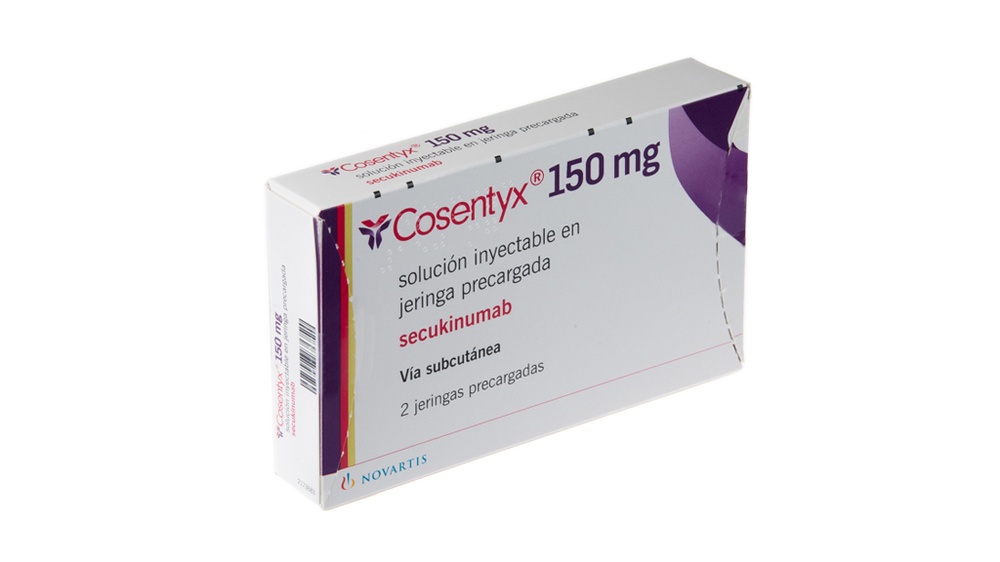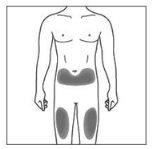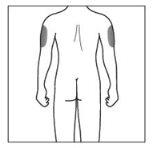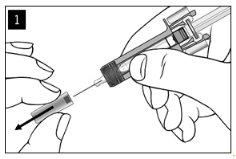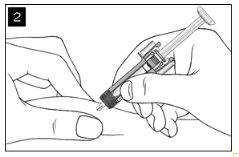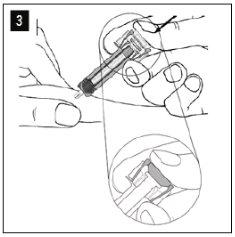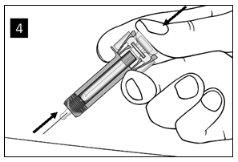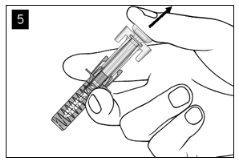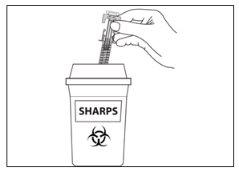
Como usar COSENTYX 150 mg SOLUÇÃO INJETÁVEL EM SERINGA PREENCHIDA
Introdução
Prospecto: informação para o utilizador
Cosentyx 150mg solução injetável em seringa pré-carregada
secucinumab
Leia todo o prospecto atentamente antes de começar a usar este medicamento, porque contém informações importantes para si.
- Conserva este prospecto, porque pode ter que voltar a lê-lo.
- Se tiver alguma dúvida, consulte o seu médico, farmacêutico ou enfermeiro.
‑ Este medicamento foi prescrito apenas para si, e não deve dá-lo a outras pessoas, mesmo que tenham os mesmos sintomas que si, porque pode prejudicá-las.
- Se experimentar efeitos adversos, consulte o seu médico, farmacêutico ou enfermeiro, mesmo que se trate de efeitos adversos que não aparecem neste prospecto. Ver secção 4.
Conteúdo do prospecto
- O que é Cosentyx e para que é utilizado
- O que precisa saber antes de começar a usar Cosentyx
- Como usar Cosentyx
- Posíveis efeitos adversos
- Conservação de Cosentyx
- Conteúdo do envase e informação adicional
1. O que é Cosentyx e para que é utilizado
Cosentyx contém o princípio ativo secucinumab. Secucinumab é um anticorpo monoclonal que pertence a um grupo de medicamentos conhecidos como “inibidores de interleucinas”. Actua neutralizando a atividade de uma proteína denominada IL-17A, que está presente em quantidades elevadas em doenças como a psoríase, a hidradenite supurativa, a artrite psoriásica e a espondiloartrite axial.
Cosentyx é utilizado para o tratamento das seguintes doenças inflamatórias:
- Psoríase em placas
- Hidradenite supurativa
- Artrite psoriásica
- Espondiloartrite axial, incluindo a espondilite anquilosante (espondiloartrite axial radiográfica) e a espondiloartrite axial não radiográfica
- Artrite idiopática juvenil, incluindo artrite relacionada com entesite e artrite psoriásica juvenil
Psoríase em placas
Cosentyx é usado para o tratamento de uma doença da pele conhecida como “psoríase em placas” que provoca inflamação na pele. Cosentyx reduz a inflamação e outros sintomas da doença. Cosentyx é usado em pessoas adultas, adolescentes e crianças (a partir de 6 anos de idade) que sofrem de psoríase em placas de natureza moderada a grave.
Usar Cosentyx para psoríase em placas beneficiará-o, pois produz melhorias no aspecto da pele e a diminuição de sintomas, tais como a descamação, o prurido e a dor.
Hidradenite supurativa
Cosentyx é usado para o tratamento de uma doença conhecida como hidradenite supurativa, também denominada em algumas ocasiões como acné inverso ou doença de Verneuil. Esta patologia é uma doença inflamatória crónica e dolorosa da pele. Os sintomas podem incluir nódulos dolorosos (bolhas) e abscessos (furónculos) dos quais pode sair pus. Comumente afeta áreas específicas da pele, como debaixo dos seios, as axilas, a parte interna das coxas, a virilha e as nádegas. Também pode produzir cicatrização nas áreas afetadas.
Cosentyx pode reduzir o número de nódulos e abscessos que tem e a dor que frequentemente se associa à doença. Se sofre de hidradenite supurativa, primeiro serão administrados outros medicamentos. Se não responder suficientemente bem a estes medicamentos, será administrado Cosentyx.
Cosentyx é utilizado em adultos com hidradenite supurativa e pode ser utilizado sozinho ou com antibióticos.
Artrite psoriásica
Cosentyx é usado para o tratamento de uma doença conhecida como “artrite psoriásica”. Trata-se de uma doença inflamatória das articulações, frequentemente acompanhada de psoríase. Se sofre de artrite psoriásica ativa, receberá primeiro outros medicamentos. Se não responder suficientemente bem a estes medicamentos, receberá Cosentyx para reduzir os sinais e sintomas da artrite psoriásica ativa, melhorar a função física e retardar o dano no cartilagem e ossos das articulações envolvidas na doença.
Cosentyx é usado em adultos com artrite psoriásica ativa e pode ser utilizado sozinho ou com outro medicamento denominado metotrexato.
Usar Cosentyx para artrite psoriásica beneficiará-o, pois reduz os sinais e sintomas da doença, retardando o dano nos cartilagens e ossos das articulações e melhorando a sua capacidade para realizar as atividades diárias normais.
Espondiloartrite axial, incluindo a espondilite anquilosante (espondiloartrite axial radiográfica) e a espondiloartrite axial não radiográfica
Cosentyx é usado para o tratamento de doenças conhecidas como “espondilite anquilosante” e “espondiloartrite axial não radiográfica”. Trata-se de doenças inflamatórias que afetam principalmente a coluna, causando inflamação das articulações da coluna. Se sofre de espondilite anquilosante ou espondiloartrite axial não radiográfica, receberá primeiro outros medicamentos. Se não responder suficientemente bem a estes medicamentos, receberá Cosentyx para reduzir os sinais e sintomas da doença, reduzir a inflamação e melhorar a sua função física.
Cosentyx é usado em adultos com espondilite anquilosante ativa e espondiloartrite axial não radiográfica ativa.
Usar Cosentyx para espondilite anquilosante e espondiloartrite axial não radiográfica beneficiará-o, pois reduz os sinais e sintomas da doença e melhora a função física.
Artrite idiopática juvenil, incluindo artrite relacionada com entesite e artrite psoriásica juvenil
Cosentyx é usado em pacientes (a partir de 6 anos de idade) para tratar a doença de artrite idiopática juvenil nas categorias denominadas “artrite relacionada com entesite” e “artrite psoriásica juvenil”. Trata-se de doenças inflamatórias que afetam as articulações e os locais onde os tendões se unem ao osso.
Usar Cosentyx em artrite relacionada com entesite e artrite psoriásica juvenil beneficiará-o (ou ao seu filho), reduzindo os sintomas e melhorando a função física (ou a do seu filho).
2. O que precisa saber antes de começar a usar Cosentyx
Não use Cosentyx:
- se é alérgicoao secucinumab ou a algum dos outros componentes deste medicamento (incluídos na secção 6).
Se suspeita que é alérgico, consulte o seu médico antes de usar Cosentyx.
- se tem alguma infecção ativaque o seu médico considere importante (por exemplo, tuberculose ativa).
Advertências e precauções
Consulte o seu médico, enfermeiro ou farmacêutico antes de usar Cosentyx:
- se contraiu uma infecção.
- se sofre de infecções repetidas ou prolongadas.
- se já teve alguma vez uma reação alérgica ao látex.
- se sofre de uma doença inflamatória que afeta o seu intestino, denominada doença de Crohn.
- se sofre de uma inflamação do intestino grosso, denominada colite ulcerosa.
- se foi vacinado recentemente ou vai ser vacinado durante o tratamento com Cosentyx.
- se segue algum outro tratamento para a psoríase, como por exemplo, se usa outros imunossupressores ou fototerapia com luz ultravioleta (UV).
Tuberculose
Informa o seu médico se sofre ou sofreu previamente de tuberculose e se sabe que esteve recentemente em contacto próximo com alguém que sofre de tuberculose. O seu médico o examinará e pode fazer um teste de tuberculose antes de receber Cosentyx. Se o seu médico acredita que está em risco de sofrer de tuberculose, pode ser administrado medicamentos para tratar a tuberculose. Se durante o tratamento com Cosentyx aparecerem sintomas de tuberculose (como tosse persistente, perda de peso, apatia ou febre leve), informe o seu médico imediatamente.
Hepatite B
Informa o seu médico se sofre ou sofreu previamente de uma infecção por hepatite B. Este medicamento pode provocar uma reativação da infecção. Antes e durante o tratamento com secucinumab, é possível que o seu médico o examine em busca de sinais de infecção. Informe o seu médico se nota algum dos sintomas seguintes: piora do cansaço, coloração amarelada da pele ou da parte branca dos olhos, urina escura, perda de apetite, náuseas e/ou dor na parte superior direita da zona do estômago.
Doença inflamatória intestinal (doença de Crohn ou colite ulcerosa)
Deixe de usar Cosentyx e informe o seu médico ou procure ajuda médica imediatamente se nota cãibras abdominais e dor, diarreia, perda de peso, sangue nas fezes ou qualquer outro sinal de problemas intestinais.
Vigie a aparência de infecções e reações alérgicas
Cosentyx pode causar potencialmente efeitos adversos graves, incluindo infecções e reações alérgicas. Deve vigiar a aparência de sinais destas doenças enquanto usa Cosentyx.
Interrompa o tratamento com Cosentyx e avise o seu médico ou procure assistência médica imediatamente se nota algum dos sinais que indicam uma possível infecção ou reação alérgica graves. Estes sinais estão incluídos na secção 4 “Posíveis efeitos adversos”.
Crianças e adolescentes
Não se recomenda o uso de Cosentyx em crianças menores de 6 anos de idade com psoríase em placas, pois não foi estudado o medicamento em pessoas desta idade.
Não se recomenda o uso de Cosentyx em crianças menores de 6 anos de idade com artrite idiopática juvenil (artrite relacionada com entesite e artrite psoriásica juvenil).
Não se recomenda o uso de Cosentyx em crianças e adolescentes (menores de 18 anos) em outras indicações, pois não foi estudado o medicamento em pessoas desta idade.
Outros medicamentos e Cosentyx
Informa o seu médico ou farmacêutico:
- se está a tomar, tomou ou pode ter que tomar qualquer outro medicamento.
- se foi vacinado recentemente ou vai ser vacinado próximamente. Não lhe devem ser administrados certos tipos de vacinas (vacinas vivas) enquanto usa Cosentyx.
Gravidez, lactação e fertilidade
- É preferível que evite o uso de Cosentyx durante a gravidez. Desconhece-se o efeito deste medicamento em mulheres grávidas. Se é uma mulher em idade fértil, aconselha-se que evite engravidar e deve utilizar um anticonceptivo adequado enquanto usa Cosentyx e durante pelo menos 20 semanas após a última dose de Cosentyx. Consulte o seu médico se está grávida, acredita que possa estar grávida ou tem intenção de engravidar.
- Consulte o seu médico se está a amamentar ou tem previsto amamentar. O senhor e o seu médico devem decidir se vai amamentar ou vai utilizar Cosentyx. Não pode fazer as duas coisas. Após utilizar Cosentyx não deve amamentar durante pelo menos 20 semanas após a última dose.
Condução e uso de máquinas
Não é provável que Cosentyx influencie a sua capacidade para conduzir ou utilizar máquinas.
3. Como usar Cosentyx
Siga exatamente as instruções de administração deste medicamento indicadas pelo seu médico. Em caso de dúvida, consulte novamente o seu médico, farmacêutico ou enfermeiro.
Cosentyx é administrado por meio de uma injeção debaixo da pele (ou seja, por via subcutânea). O senhor e o seu médico devem decidir se deve ser o senhor mesmo a se injetar Cosentyx.
É importante que não tente injetar o medicamento até que o médico, enfermeiro ou farmacêutico o tenham ensinado a fazê-lo. A pessoa que o cuida também pode pôr a injeção de Cosentyx após ter recebido a formação oportuna.
No apartado “Instruções de uso de Cosentyx 150 mg em seringa pré-carregada” que se encontra no final deste prospecto, são dadas instruções detalhadas de como administrar Cosentyx.
As instruções de uso também podem ser encontradas através do seguinte código QR e site:
‘Código QR a incluir’
www.cosentyx.eu
Quanto Cosentyx deve ser administrado e durante quanto tempo
O seu médico decidirá quanto Cosentyx o senhor precisa e durante quanto tempo.
Psoríase em placas
Adultos
- A dose recomendada é 300 mg por injeção subcutânea.
- Uma dose de 300 mg é administrada mediante duas injeções de 150mg.
Após a primeira dose, o senhor receberá injeções semanais nas semanas 1, 2, 3 e 4 seguidas de injeções mensais. De acordo com a sua resposta, o seu médico pode recomendar ajustes adicionais da dose. Em cada consulta, o senhor receberá uma dose de 300 mg repartida em duas injeções de 150 mg.
Crianças a partir de 6anos de idade
- A dose recomendada está baseada no peso corporal da seguinte forma:
- Peso inferior a 25 kg: 75 mg mediante injeção subcutânea.
- Peso entre 25 kg e abaixo de 50 kg: 75 mg mediante injeção subcutânea.
- Peso a partir de 50 kg: 150 mg mediante injeção subcutânea.
O seu médico pode aumentar a dose para 300 mg.
- Cada dose de 150 mg é administrada como uma injeção de 150mg. Para a administração das doses de 75 mg e 300 mg podem estar disponíveis outras formas de dosificação/concentrações.
Após a primeira dose, o senhor receberá injeções semanais nas semanas 1, 2, 3 e 4 seguidas de injeções mensais.
Hidradenite supurativa
- A dose recomendada é de 300 mg por injeção subcutânea.
- Cada dose de 300 mg é administrada como duas injeções de 150mg.
Após a primeira dose, o senhor receberá injeções semanais nas semanas 1, 2, 3 e 4 seguidas de injeções mensais. De acordo com a sua resposta, o seu médico pode recomendar ajustes adicionais da dose.
Artrite psoriásica
Se sofre de artrite psoriásica e também de psoríase em placas de moderada a grave, o seu médico pode ajustar a dose recomendada conforme necessário.
Para pacientes que não responderam bem a medicamentos conhecidos como bloqueadores do fator de necrose tumoral (TNF):
- A dose recomendada é 300 mg por injeção subcutânea.
- Cada dose de 300 mg é administrada mediante duas injeções de 150mg.
Após a primeira dose, o senhor receberá injeções semanais nas semanas 1, 2, 3 e 4 seguidas de injeções mensais. Em cada consulta, o senhor receberá uma dose de 300 mg repartida em duas injeções de 150 mg.
Para o resto dos pacientes com artrite psoriásica:
- A dose recomendada é 150 mg por injeção subcutânea.
Após a primeira dose, o senhor receberá injeções semanais nas semanas 1, 2, 3 e 4 seguidas de injeções mensais.
De acordo com a sua resposta, o seu médico pode aumentar a dose para 300 mg.
Espondilite anquilosante (Espondiloartrite axial radiográfica)
- A dose recomendada é 150 mg por injeção subcutânea.
Após a primeira dose, o senhor receberá injeções semanais nas semanas 1, 2, 3 e 4 seguidas de injeções mensais.
De acordo com a sua resposta, o seu médico pode aumentar a dose para 300 mg. Cada dose de 300 mg é administrada mediante duas injeções de 150 mg.
Espondiloartrite axial não radiográfica
- A dose recomendada é de 150 mg por injeção subcutânea.
Após a primeira dose, o senhor receberá injeções semanais nas semanas 1, 2, 3 e 4 seguidas de injeções mensais.
Artrite idiopática juvenil (artrite relacionada com entesite e artrite psoriásica juvenil)
- A dose recomendada está baseada no peso corporal da seguinte forma:
- Peso inferior a 50 kg: 75 mg mediante injeção subcutânea.
- Peso a partir de 50 kg: 150 mg mediante injeção subcutânea.
- Cada dose de 150 mg é administrada como uma injeção de 150 mg. Para a administração da dose de 75 mg podem estar disponíveis outras formas de dosificação/concentrações.
Após a primeira dose, o senhor (ou o seu filho) receberão injeções semanais nas semanas 1, 2, 3 e 4 seguidas de injeções mensais.
Cosentyx é um tratamento de longa duração. O seu médico controlará periodicamente o estado da sua doença para comprobar se o tratamento surte o efeito desejado.
Se usa mais Cosentyx do que deve
Se receber mais Cosentyx do que deve ou a dose foi administrada antes do tempo indicado pelo seu médico, informe o seu médico.
Se esqueceu de usar Cosentyx
Se esqueceu de uma dose de Cosentyx, injete a próxima dose assim que se lembrar. Depois, fale com o médico para que lhe diga quando deve injetar a dose seguinte.
Se interromper o tratamento com Cosentyx
Não é perigoso deixar de usar Cosentyx. No entanto, se o fizer, é possível que reapareçam os sintomas de psoríase, artrite psoriásica ou espondiloartrite axial.
Se tiver alguma outra dúvida sobre o uso deste medicamento, pergunte ao seu médico, farmacêutico ou enfermeiro.
4. Efeitos adversos possíveis
Assim como todos os medicamentos, este medicamento pode produzir efeitos adversos, embora nem todas as pessoas os sofram.
Efeitos adversos graves
Interrompa o tratamento com Cosentyx e informe seu médico ou procure imediatamente assistência médica se notar algum dos seguintes efeitos adversos:
Possible infecção grave– os sinais podem incluir:
- febre, sintomas gripais, suores noturnos
- sensação de cansaço ou dificuldade para respirar, tos persistente
- pele quente, vermelha e dolorosa ao toque, ou erupção dolorosa com bolhas
- ardor ao urinar.
Reação alérgica grave– os sinais podem incluir:
- dificuldade para respirar ou engolir
- pressão arterial baixa, que pode causar tontura ou um ligeiro aturdimento
- inchaço do rosto, lábios, língua ou garganta
- coceira (prurido) intensa da pele acompanhada de erupção ou bolhas.
Seu médico decidirá se deve e quando reiniciar o tratamento.
Outros efeitos adversos
A maioria dos seguintes efeitos adversos é leve ou moderada. Se em algum caso se tornarem graves, informe seu médico, farmacêutico ou enfermeiro.
Muito frequentes(podem afetar mais de 1 de cada 10 pessoas):
- infecções das vias respiratórias altas com sintomas como dor de garganta e congestão nasal (rinofaringite, rinite).
Frequentes(podem afetar até 1 de cada 10 pessoas):
- úlceras bucais (herpes oral)
- diarreia
- secreção nasal (rinorreia)
- dor de cabeça
- náusea
- fadiga
- coceira, vermelhidão e secura da pele (eczema)
Pouco frequentes(podem afetar até 1 de cada 100 pessoas):
- aftas bucais (candidíase oral)
- sinais de escassez de glóbulos brancos, como febre, dor de garganta ou úlceras bucais devido a infecções (neutropenia)
- infecção do ouvido externo (otite externa)
- supuração do olho com coceira, vermelhidão e inchaço (conjuntivite)
- erupção com coceira (urticária)
- infecções de vias respiratórias baixas
- cãibras abdominais, dor abdominal, diarreia, perda de peso ou sangue nas fezes (sinais de problemas intestinais)
- bolhas pequenas com coceira nas palmas das mãos, nas plantas dos pés e nos bordos dos dedos das mãos e dos pés (eczema dishidrótico)
- pé de atleta (tinha pedis)
Raros(podem afetar até 1 de cada 1.000 pessoas):
- reação alérgica grave com choque (reação anafilática)
- vermelhidão e descamação da pele de uma zona extensa do corpo, que pode ser coceira ou dolorosa (dermatite exfoliativa)
- inflamação dos vasos sanguíneos pequenos, que pode dar lugar a uma erupção cutânea com pequenos bultos vermelhos ou roxos (vasculite)
- inchaço do pescoço, da face, da boca ou da garganta que pode dar lugar a dificuldade para engolir ou respirar (angioedema)
Frequência não conhecida(não pode ser estimada a partir dos dados disponíveis):
- infecções fúngicas da pele e membranas mucosas (incluindo candidíase esofágica)
- inchaço doloroso e ulceração da pele (pioderma gangrenoso)
Comunicação de efeitos adversos
Se experimentar qualquer tipo de efeito adverso, consulte seu médico, farmacêutico ou enfermeiro, mesmo que se trate de possíveis efeitos adversos que não aparecem neste prospecto. Também pode comunicá-los diretamente através do sistema nacional de notificação incluído no Apêndice V. Mediante a comunicação de efeitos adversos, você pode contribuir para proporcionar mais informações sobre a segurança deste medicamento.
5. Conservação de Cosentyx
Mantenha este medicamento fora da vista e do alcance das crianças.
Não utilize este medicamento:
- após a data de validade que aparece na caixa ou na etiqueta da seringa após “CAD”/”EXP”.
- se o líquido contém partículas facilmente visíveis, está turvo ou tem um colorido claramente marrom.
Conservar a seringa precintada em sua caixa para protegê-la da luz. Conservar na geladeira entre 2 °C e 8 °C. Não congelar. Não agitar.
Se necessário, Cosentyx pode ser deixado fora da geladeira durante um único período de até 4 dias a temperatura ambiente, não superior a 30 °C.
Este medicamento é de uso único.
Os medicamentos não devem ser jogados nos deságues. Pergunte ao seu farmacêutico como se livrar dos medicamentos que já não precisa. Dessa forma, ajudará a proteger o meio ambiente.
6. Conteúdo do envase e informações adicionais
Composição de Cosentyx
- O princípio ativo é secucinumab. Cada seringa precargada contém 150 mg de secucinumab.
- Os demais componentes são trealose diidratado, histidina, cloreto de histidina monoidratado, metionina, polissorbato 80 e água para preparações injetáveis.
Aspecto de Cosentyx e conteúdo do envase
Cosentyx solução injetável é um líquido transparente. Sua cor varia de incoloro a ligeiramente amarelado.
Cosentyx 150 mg solução injetável em seringa precargada é apresentado em envases unitários de 1 ou 2 seringa(s) precargada(s) e em envases múltiplos que contêm 6 (3 envases de 2) seringas precargadas.
Pode que não estejam comercializados todos os tamanhos de envases.
Titular da autorização de comercialização
Novartis Europharm Limited
Vista Building
Elm Park, Merrion Road
Dublin 4
Irlanda
Responsável pela fabricação
Novartis Pharma GmbH
Roonstraße 25
90429 Nuremberg
Alemanha
Sandoz GmbH
Biochemiestrasse 10
6336 Langkampfen
Áustria
Novartis Pharmaceutical Manufacturing GmbH
Biochemiestrasse 10
6336 Langkampfen
Áustria
Novartis Pharma GmbH
Sophie-Germain-Strasse 10
90443 Nürnberg
Alemanha
Podem solicitar mais informações sobre este medicamento dirigindo-se ao representante local do titular da autorização de comercialização:
Bélgica Novartis Pharma N.V. Tel: +32 2 246 16 11 | Lituânia SIA Novartis Baltics Lietuvos filialas Tel: +370 5 269 16 50 |
| Luxemburgo Novartis Pharma N.V. Tel: +32 2 246 16 11 |
República Tcheca Novartis s.r.o. Tel: +420 225 775 111 | Hungria Novartis Hungária Kft. Tel.: +36 1 457 65 00 |
Dinamarca Novartis Healthcare A/S Tlf.: +45 39 16 84 00 | Malta Novartis Pharma Services Inc. Tel: +356 2122 2872 |
Alemanha Novartis Pharma GmbH Tel: +49 911 273 0 | Países Baixos Novartis Pharma B.V. Tel: +31 88 04 52 111 |
Estônia SIA Novartis Baltics Eesti filiaal Tel: +372 66 30 810 | Noruega Novartis Norge AS Tlf: +47 23 05 20 00 |
Grécia Novartis (Hellas) A.E.B.E. Tel: +30 210 281 17 12 | Áustria Novartis Pharma GmbH Tel: +43 1 86 6570 |
Espanha Novartis Farmacéutica, S.A. Tel: +34 93 306 42 00 | Polônia Novartis Poland Sp. z o.o. Tel.: +48 22 375 4888 |
França Novartis Pharma S.A.S. Tel: +33 1 55 47 66 00 | Portugal Novartis Farma – Produtos Farmacêuticos, S.A. Tel: +351 21 000 8600 |
Croácia Novartis Hrvatska d.o.o. Tel. +385 1 6274 220 | Romênia Novartis Pharma Services Romania SRL Tel: +40 21 31299 01 |
Irlanda Novartis Ireland Limited Tel: +353 1 260 12 55 | Eslovênia Novartis Pharma Services Inc. Tel: +386 1 300 75 50 |
Islândia Vistor hf. Sími: +354 535 7000 | República Eslovaca Novartis Slovakia s.r.o. Tel: +421 2 5542 5439 |
Itália Novartis Farma S.p.A. Tel: +39 02 96 54 1 | Finlândia Novartis Finland Oy Puh/Tel: +358 (0)10 6133 200 |
Chipre Novartis Pharma Services Inc. Tel: +357 22 690 690 | Suécia Novartis Sverige AB Tel: +46 8 732 32 00 |
Letônia SIA Novartis Baltics Tel: +371 67 887 070 |
Data da última revisão deste prospecto:
Outras fontes de informação
A informação detalhada deste medicamento está disponível na página web da Agência Europeia de Medicamentos: http://www.ema.europa.eu
Instruções de uso de Cosentyx 150 mg em seringa precargada
Leia TODAS as instruções antes de injetar o medicamento. É importante que não tente injetar o medicamento ou a uma pessoa sob seu cuidado até que o médico, enfermeiro ou farmacêutico o tenham ensinado a fazer. A caixa contém a(s) seringa(s) precargada(s) de Cosentyx 150 mg dentro de um blister de plástico.
Sua Cosentyx 150 mg em seringa precargada
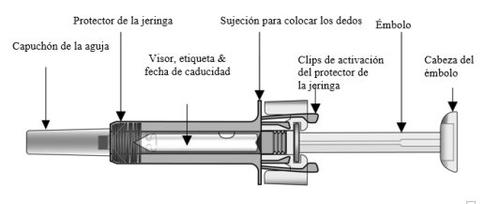
Uma vez que o medicamento seja injetado, o protetor para cobrir a agulha se ativará. Este é concebido para proteger de lesões por picadas acidentais os profissionais de saúde, os pacientes que se autoinjetam o medicamento prescrito pelo médico e os indivíduos que ajudam os pacientes a se autoinjetarem o medicamento.
O que mais precisa para a injeção:
|
|
Informação importante de segurança
Aviso: Mantenha a seringa fora da vista e do alcance das crianças.
- O capuchão da agulha da seringa pode conter goma seca (látex) que não devem tocar as pessoas sensíveis a ela.
- Não abra a caixa até que esteja pronto para aplicar este medicamento.
- Não use este medicamento se o selo da caixa ou o blister estiver quebrado, pois pode não ser seguro utilizá-lo.
- Não utilize a seringa se cair sobre uma superfície dura ou se cair após retirar o capuchão da agulha.
- Nunca deixe a seringa em locais onde outras pessoas possam tocá-la.
- Não agite a seringa.
- Tenha muito cuidado para não tocar os cliques de ativação antes de sua utilização. Se o fizer, se disparará o protetor da agulha antes do tempo.
- Não retire o capuchão da agulha até justo antes de aplicar a injeção.
- Não se pode reutilizar a seringa. Uma vez utilizada, descarte a seringa no cubo de eliminação de objetos pontiagudos.
Conservação de Cosentyx 150 mg em seringa precargada
- Conservar este medicamento precintado dentro de sua caixa para protegê-lo da luz. Conservar na geladeira entre 2°C e 8°C. NÃO CONGELAR.
- Lembre-se de sacar a seringa da geladeira para que se atempere antes de preparar a injeção (15-30 minutos).
- Não utilize a seringa após a data de validade que aparece na caixa ou na etiqueta da seringa após “CAD”/”EXP”. Se expirou, devolva o envase completo à farmácia.
Locais de injeção
| O local da injeção é o sitio onde você se aplicará a seringa.
|
| Se quem aplica a injeção é a pessoa que cuida do paciente, então também se pode utilizar a parte superior dos braços. |
Preparação de Cosentyx 150 mg em seringa precargada pronta para utilizar
Nota: Para uma dose de 150 mg, prepare 1 seringa precargada e injete o conteúdo. Para a dose de 300 mg, prepare 2 seringas precargadas e injete o conteúdo de ambas.
- Saque da geladeira a caixa com a seringa e deixe-a sem abrirpor uns 15-30 minutos para que se atempere.
- Quando estiver pronto para utilizar a seringa, lave bem as mãos com água e sabão.
- Desinfete bem a zona de injeção com uma toalhita umedecida com álcool.
- Retire a seringa da caixa e saque-a do blister segurando o corpo protetor da seringa.
- Inspeccione a seringa. O líquido deve ser transparente. Sua cor pode variar de incoloro a ligeiramente amarelado. Pode haver alguma bolha de ar pequena, que é normal. NÃO UTILIZE se o líquido contém partículas, está turvo ou tem um colorido claramente marrom. NÃO UTILIZE se a seringa estiver quebrada. Em todos esses casos, devolva o envase completo à farmácia.
Como utilizar a seringa precargada de Cosentyx 150 mg
| Retire com cuidado o capuchão da agulha da seringa segurando o corpo protetor da seringa. Descarte-o. Pode que observe uma gota na ponta da agulha. Isso é normal. |
| Pegue suavemente a pele do local da injeção e insira a agulha como mostra a figura. Introduza a agulha por completo para garantir que se administre todo o medicamento. Segure a seringa como se mostra. Pressione lentamenteo êmbolo até o finalde tal maneira que a cabeça do êmbolo fique encaixada nos cliques de ativação do protetor. Mantenha pressionado o êmbolo enquanto mantém a seringa nessa posição durante 5 segundos. |
| Sem soltar o êmbolo, retire cuidadosamente a agulha do local da injeção. |
| Solte o êmbolo lentamente e deixe que o protetor tape automaticamente a agulha. Pode que haja um pouco de sangue no local da injeção. Pode pressionar durante 10 segundos com um algodão ou uma gaze a zona da injeção. Não se esfregue o local da injeção. Pode colocar uma tirinha se necessário. |
Instruções de eliminação
| Descarte a seringa usada em um cubo de eliminação de objetos pontiagudos (recipiente fechado e resistente a picadas). Por motivos de segurança e de saúde (de você e de outras pessoas), as agulhas e as seringas usadas nuncadevem ser reutilizadas. |
- País de registo
- Substância ativa
- Requer receita médicaSim
- Fabricante
- Esta informação é apenas para referência e não constitui aconselhamento médico. Consulte sempre um médico antes de tomar qualquer medicamento. A Oladoctor não se responsabiliza por decisões médicas baseadas neste conteúdo.
- Alternativas a COSENTYX 150 mg SOLUÇÃO INJETÁVEL EM SERINGA PREENCHIDAForma farmacêutica: INJETÁVEL, 150mg/1mlSubstância ativa: secukinumabFabricante: Novartis Europharm LimitedRequer receita médicaForma farmacêutica: INJETÁVEL, 150 mg de secukinumab / mlSubstância ativa: secukinumabFabricante: Novartis Europharm LimitedRequer receita médicaForma farmacêutica: INJETÁVEL, 150mg/1mlSubstância ativa: secukinumabFabricante: Novartis Europharm LimitedRequer receita médica
Alternativas a COSENTYX 150 mg SOLUÇÃO INJETÁVEL EM SERINGA PREENCHIDA noutros países
As melhores alternativas com o mesmo princípio ativo e efeito terapêutico.
Alternativa a COSENTYX 150 mg SOLUÇÃO INJETÁVEL EM SERINGA PREENCHIDA em Ukraine
Médicos online para COSENTYX 150 mg SOLUÇÃO INJETÁVEL EM SERINGA PREENCHIDA
Avaliação de posologia, efeitos secundários, interações, contraindicações e renovação da receita de COSENTYX 150 mg SOLUÇÃO INJETÁVEL EM SERINGA PREENCHIDA – sujeita a avaliação médica e regras locais.



